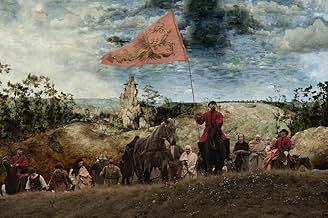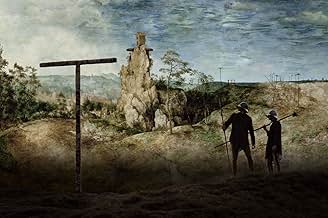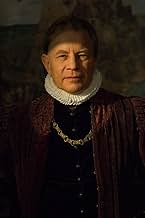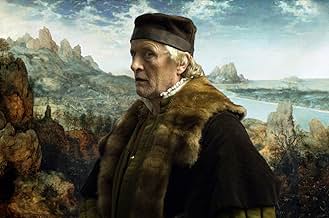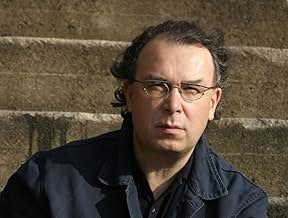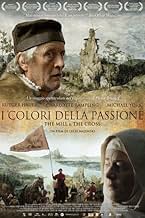NOTE IMDb
6,8/10
4,6 k
MA NOTE
Ajouter une intrigue dans votre langueThis movie focuses on a dozen of the five hundred characters depicted in Bruegel's painting. The theme of Christ's suffering is set against religious persecution in Flanders in 1564.This movie focuses on a dozen of the five hundred characters depicted in Bruegel's painting. The theme of Christ's suffering is set against religious persecution in Flanders in 1564.This movie focuses on a dozen of the five hundred characters depicted in Bruegel's painting. The theme of Christ's suffering is set against religious persecution in Flanders in 1564.
- Réalisation
- Scénario
- Casting principal
- Récompenses
- 10 victoires et 7 nominations au total
Avis à la une
The Mill and the Cross is a movie inside of a painting, specifically The Way to Calvary (1564) by Pieter Bruegel the Elder. Pieter Bruegel (Rutger Hauer) is the main character in the film which takes turns following him as he decides how his painting will take shape and who will be in it and also follows the local peasants who go about their daily business in middle of 16th century Flanders. The background is always the actual painting's background with the mill high up on a rock looking down on a large field where most of the action occurs.
Bruegel's patron is Nicolaes Jonghelinck (Michael York), a successful Flemish banker who spends his time learning from Bruegel about the people in the painting and what each section represents and also pontificates to nobody in particular about the current state of affairs in Flanders. In 1564, Spain ruled what is now Antwerp and Flanders. The Spanish militia seen in the painting in their red tunics seemed to be preoccupied with chasing down and torturing Protestant heretics. There are gruesome scenes in the film with a man tied to a wagon wheel hoisted up in the air with no defense at all while the birds have at him. A woman's fate is no better as she is shoved alive into an open grave while the red tunics fill the dirt in on top of her.
The Way to Calvary itself does not show these particular atrocities. Instead, it has Jesus in the center hoisting his own cross towards his crucifixion. The exact moment the painting captures is Simon helping him with the cross because Jesus stumbled and fell down. Everyone's eyes are on Simon at this time instead of Jesus. In the foreground is Mary (Charlotte Rampling). She is helpless as she sits on the sidelines because there is nothing she can do to prevent the red tunics from carrying out their mission. The rest of the painting shows hundreds of peasants either watching the proceeding or going about their chores. Children play games on the hillside, a local peddler sells his bread, a horn player dances around, and above them all, the miller observes from his windmill.
The Mill and the Cross is at its best when Bruegel is explaining his inspiration and how he plans to incorporate all of his ideas and scenes into one large landscape. He looks closely at a spider's web to discover where the anchor point on his painting will be and how to section off the rest of the action. Just as intriguing are the scenes of everyday life in 1564 Flanders. A young couple gets out of bed and takes their cow to the field for the day. Bruegel's wife and children wake up after him and get ready for breakfast which is a small slice of bread. The miller and his apprentice ready the mill for the day's tasks and the large wheels and gears moan into action.
Rutger Hauer is excellent as Pieter Bruegel and he appears to be serving his artistic penance to atone for his ridiculous participation in Hobo with a Shotgun earlier this year. Michael York is taking a break from his voice over work and TV appearances to finally show up in a serious film again. Charlotte Rampling is sort of the odd man out here. Her screen time is sparse as Mary and she spends most of the time misty eyed observing all of the peasant movements around her.
The Mill and the Cross is a Polish production directed by Lech Majewski who also aided in adapting the screenplay from a book of the same name by Michael Francis Gibson. The film was an official selection at this year's Sundance Film Festival and will most likely earn an Oscar nod for Best Costume Design. The costumes are remarkable and frequently take center stage over the performers.
The Mill and the Cross is a bit reminiscent of The Girl with a Pearl Earring but instead of showing how the painting is made from the outside, this time, the filmmakers actually take you inside of the painting itself and walks on the same landscape as its subjects. There is little dialogue in the film which is not a problem because it is so absorbing to just sit back and watch the peasants wander around the area and Bruegel figure out how to tie everything together. I will not give it away, but the final shot of the film is as wonderful as the rest as the camera backs up and reveals something to the audience.
If you are a movie patron with patience and an interest in art history, The Mill and the Cross is for you. If you get bored in movies without guns, flash bangs, and screaming, stay away.
Bruegel's patron is Nicolaes Jonghelinck (Michael York), a successful Flemish banker who spends his time learning from Bruegel about the people in the painting and what each section represents and also pontificates to nobody in particular about the current state of affairs in Flanders. In 1564, Spain ruled what is now Antwerp and Flanders. The Spanish militia seen in the painting in their red tunics seemed to be preoccupied with chasing down and torturing Protestant heretics. There are gruesome scenes in the film with a man tied to a wagon wheel hoisted up in the air with no defense at all while the birds have at him. A woman's fate is no better as she is shoved alive into an open grave while the red tunics fill the dirt in on top of her.
The Way to Calvary itself does not show these particular atrocities. Instead, it has Jesus in the center hoisting his own cross towards his crucifixion. The exact moment the painting captures is Simon helping him with the cross because Jesus stumbled and fell down. Everyone's eyes are on Simon at this time instead of Jesus. In the foreground is Mary (Charlotte Rampling). She is helpless as she sits on the sidelines because there is nothing she can do to prevent the red tunics from carrying out their mission. The rest of the painting shows hundreds of peasants either watching the proceeding or going about their chores. Children play games on the hillside, a local peddler sells his bread, a horn player dances around, and above them all, the miller observes from his windmill.
The Mill and the Cross is at its best when Bruegel is explaining his inspiration and how he plans to incorporate all of his ideas and scenes into one large landscape. He looks closely at a spider's web to discover where the anchor point on his painting will be and how to section off the rest of the action. Just as intriguing are the scenes of everyday life in 1564 Flanders. A young couple gets out of bed and takes their cow to the field for the day. Bruegel's wife and children wake up after him and get ready for breakfast which is a small slice of bread. The miller and his apprentice ready the mill for the day's tasks and the large wheels and gears moan into action.
Rutger Hauer is excellent as Pieter Bruegel and he appears to be serving his artistic penance to atone for his ridiculous participation in Hobo with a Shotgun earlier this year. Michael York is taking a break from his voice over work and TV appearances to finally show up in a serious film again. Charlotte Rampling is sort of the odd man out here. Her screen time is sparse as Mary and she spends most of the time misty eyed observing all of the peasant movements around her.
The Mill and the Cross is a Polish production directed by Lech Majewski who also aided in adapting the screenplay from a book of the same name by Michael Francis Gibson. The film was an official selection at this year's Sundance Film Festival and will most likely earn an Oscar nod for Best Costume Design. The costumes are remarkable and frequently take center stage over the performers.
The Mill and the Cross is a bit reminiscent of The Girl with a Pearl Earring but instead of showing how the painting is made from the outside, this time, the filmmakers actually take you inside of the painting itself and walks on the same landscape as its subjects. There is little dialogue in the film which is not a problem because it is so absorbing to just sit back and watch the peasants wander around the area and Bruegel figure out how to tie everything together. I will not give it away, but the final shot of the film is as wonderful as the rest as the camera backs up and reveals something to the audience.
If you are a movie patron with patience and an interest in art history, The Mill and the Cross is for you. If you get bored in movies without guns, flash bangs, and screaming, stay away.
The Mill and the Cross is a painting (so not a lot of plot!) come to life and it is unlike any movie I have ever seen before (and I have seen a few)! Directed by Polish filmmaker, Lech Majewski, it is a recreation and interpretation of the famous 1564 painting by Pieter Bruegel, "The Way to Calvary".
Glacially-paced and nearly-silent (at first) ... one film critic (Stephen Cole of "Globe and Mail") said that this film's detractors will likely lament that watching this "is like watching a painting dry" (a point I can understand some having). If it doesn't grab one's interest early-on -- the film's opening is the painting coming to life and than slowly drying back onto the canvas -- there is no point in watching it.
Another film about the inspiration of a painting (that I loved) -- The Girl with the Pearl Earring -- told a possible story of how a Vermeer masterpiece came into being AND each scene was as lovely as a painted picture. Here each scene looks like a painting as well; but this story isn't necessarily one about a "what-if" (although as a film it technically is). Instead, The Mill and the Cross pretends to show us THIS painting (not the inspiration behind it) as it is being painted.
The painting is of the re-imagined crucifixion of Christ in 16th Century Flanders while the region is under BRUTAL Spanish occupation. As Bruegel (Rutger Hauer - Batman Begins, Hobo with a Shotgun, Blade Runner) draws and explains his painting, the scene comes to life so that the audience sees what Bruegel "sees". The premise and style are highly unusual but I appreciated the delicate take (layer-upon-layer of computer imaging) of telling this story.
The Mill and the Cross isn't content with looking at a piece of art -- this film is about experiencing it which is rather marvelous as the Flanders countryside comes to life (and it is as if the audience has stumbled upon the same setting/scene as Bruegel). We get bits and pieces of story but no major plot other than the painting and its scenes/images coming to life.
This wasn't a favorite of mine by any means; but I do like the originality of it and anybody with a serious interest in art might want to check it out.
Glacially-paced and nearly-silent (at first) ... one film critic (Stephen Cole of "Globe and Mail") said that this film's detractors will likely lament that watching this "is like watching a painting dry" (a point I can understand some having). If it doesn't grab one's interest early-on -- the film's opening is the painting coming to life and than slowly drying back onto the canvas -- there is no point in watching it.
Another film about the inspiration of a painting (that I loved) -- The Girl with the Pearl Earring -- told a possible story of how a Vermeer masterpiece came into being AND each scene was as lovely as a painted picture. Here each scene looks like a painting as well; but this story isn't necessarily one about a "what-if" (although as a film it technically is). Instead, The Mill and the Cross pretends to show us THIS painting (not the inspiration behind it) as it is being painted.
The painting is of the re-imagined crucifixion of Christ in 16th Century Flanders while the region is under BRUTAL Spanish occupation. As Bruegel (Rutger Hauer - Batman Begins, Hobo with a Shotgun, Blade Runner) draws and explains his painting, the scene comes to life so that the audience sees what Bruegel "sees". The premise and style are highly unusual but I appreciated the delicate take (layer-upon-layer of computer imaging) of telling this story.
The Mill and the Cross isn't content with looking at a piece of art -- this film is about experiencing it which is rather marvelous as the Flanders countryside comes to life (and it is as if the audience has stumbled upon the same setting/scene as Bruegel). We get bits and pieces of story but no major plot other than the painting and its scenes/images coming to life.
This wasn't a favorite of mine by any means; but I do like the originality of it and anybody with a serious interest in art might want to check it out.
I found this film to inspire the same contemplative mood and heightened awareness of similar films that build power without reliance on lots of dialogue, music or usual cinematic cues. If you appreciated "Into Great Silence" or "Vision" or "The Tree of Life" or even "2001" you will appreciate the poetic quality of this film. It is important for us to slow down occasionally and allow some films to affect us without the necessity of being slammed over the head with noise and speed and highly charged emotions. After all, for a film placed in its time, that is a more realistic portrayal of life during those centuries. This film illuminates the artistic process and aims of the artist. We are fortunate that the makers of this film dared to create this unique journey into a canvas of one of the world's great artists.
The Mill and the Cross (2011)
The Polish film "The Mill and the Cross" was co-written and directed by Lech Majewski It stars Rutger Hauer as Pieter Bruegel, and co-stars Charlotte Rampling and Michael York.
The film consists of an attempt to bring to life Bruegel's 1564 painting, "The Procession to Calvary." I have seen this painting in the Kunsthistoriche Museum in Vienna. Once you've seen it, you don't forget it, because it is filled with people and action. (Although, in the painting, Jesus has just collapsed under the weight of the cross, so, in a sense, action has been frozen for a few seconds.)
The painting is also remarkable for a very strange symbol--a windmill placed high atop a stony crag. In the film, Bruegel explains that the miller looks down from his mill and sees everything that is happening below, just as God looks down from heaven and can see everything. So, the mill and the miller work symbolically. However, in a practical sense, the mill would never be that high on an large, steep, stony crag. If a mill were really in that location, no one could bring the wheat to the mill or take away the flour.
The other dominant vertical structure is a cartwheel, raised high on a long pole. This was the device used by the Spanish rulers of the Netherlands to execute and display prisoners. The prisoner was tied to the wheel, and the wheel was hoisted far up in the air. The device prevented anyone from helping the person--if alive--or removing the body. Only the carrion birds could reach the body, which they did, with predictable results.
Technology in the 21st Century makes everything possible, so it's no surprise that the painting is reproduced in the film in a real landscape. Sometimes all the figures are frozen, but other times you can see a cow moving or some other action taking place. The special effects are routine by now, but the manner in which they are used is not routine.
We really have the sense that we are looking at a landscape, and the artist is putting it down on canvas before our eyes. This is a highly creative way to look at life the way an artist sees it, and then look at the way life is transformed and committed to canvas.
We saw this film on the large screen at the excellent Rochester Polish Film Festival. It really will work better in a theater. However, if that's not an option, it's worth seeing on DVD.
The Polish film "The Mill and the Cross" was co-written and directed by Lech Majewski It stars Rutger Hauer as Pieter Bruegel, and co-stars Charlotte Rampling and Michael York.
The film consists of an attempt to bring to life Bruegel's 1564 painting, "The Procession to Calvary." I have seen this painting in the Kunsthistoriche Museum in Vienna. Once you've seen it, you don't forget it, because it is filled with people and action. (Although, in the painting, Jesus has just collapsed under the weight of the cross, so, in a sense, action has been frozen for a few seconds.)
The painting is also remarkable for a very strange symbol--a windmill placed high atop a stony crag. In the film, Bruegel explains that the miller looks down from his mill and sees everything that is happening below, just as God looks down from heaven and can see everything. So, the mill and the miller work symbolically. However, in a practical sense, the mill would never be that high on an large, steep, stony crag. If a mill were really in that location, no one could bring the wheat to the mill or take away the flour.
The other dominant vertical structure is a cartwheel, raised high on a long pole. This was the device used by the Spanish rulers of the Netherlands to execute and display prisoners. The prisoner was tied to the wheel, and the wheel was hoisted far up in the air. The device prevented anyone from helping the person--if alive--or removing the body. Only the carrion birds could reach the body, which they did, with predictable results.
Technology in the 21st Century makes everything possible, so it's no surprise that the painting is reproduced in the film in a real landscape. Sometimes all the figures are frozen, but other times you can see a cow moving or some other action taking place. The special effects are routine by now, but the manner in which they are used is not routine.
We really have the sense that we are looking at a landscape, and the artist is putting it down on canvas before our eyes. This is a highly creative way to look at life the way an artist sees it, and then look at the way life is transformed and committed to canvas.
We saw this film on the large screen at the excellent Rochester Polish Film Festival. It really will work better in a theater. However, if that's not an option, it's worth seeing on DVD.
10JvH48
Many thanks to the Rotterdam filmfestival 2011 for screening this guided tour through Christ Carrying the Cross, the painting by Pieter Bruegel the Elder. I learned a lot about the ideas behind it and the way it was set up. Seeing it explained gradually throughout the story, will let me remember it better than reading about it in a book.
We also learned a lot about how people lived those days. A special mention should be devoted to the parts where this film demonstrates that life goes on, regardless of politics, war, and religions. We also saw many forgotten customs about bread, threshold cleaning, and much more that I want to leave as an exercise to the close observer.
A dramatic moment at ¾ of the film is where the painter raises his hand, and life comes to a stand still, including the mill on the hill that stops by a hand signal of the miller. It seems no coincidence that the miller very much resembles how our Lord is pictured usually, and also that he oversees the whole panorama from his high position. As soon as he signals the mill to resume working, the whole picture relives from its frozen state.
A large part of the audience stayed for the final Q&A. We got much information about the post production effort required to get the colors right, and creating the different layers to get everything in focus. Further, the film maker told he wanted to make a feature film from the start. It was considered a Mission Impossible by the people around him. How wrong they were!
All in all, a lot goes on in the film, much more than I could oversee during the screening. Maybe I should try to grasp more of the fine details during a second viewing. I don't think I saw everything that the film makers did put into this production.
We also learned a lot about how people lived those days. A special mention should be devoted to the parts where this film demonstrates that life goes on, regardless of politics, war, and religions. We also saw many forgotten customs about bread, threshold cleaning, and much more that I want to leave as an exercise to the close observer.
A dramatic moment at ¾ of the film is where the painter raises his hand, and life comes to a stand still, including the mill on the hill that stops by a hand signal of the miller. It seems no coincidence that the miller very much resembles how our Lord is pictured usually, and also that he oversees the whole panorama from his high position. As soon as he signals the mill to resume working, the whole picture relives from its frozen state.
A large part of the audience stayed for the final Q&A. We got much information about the post production effort required to get the colors right, and creating the different layers to get everything in focus. Further, the film maker told he wanted to make a feature film from the start. It was considered a Mission Impossible by the people around him. How wrong they were!
All in all, a lot goes on in the film, much more than I could oversee during the screening. Maybe I should try to grasp more of the fine details during a second viewing. I don't think I saw everything that the film makers did put into this production.
Le saviez-vous
- AnecdotesIn the movie, the two large paintings displayed behind Nicolaes Jonghelinck (Michael York) and his wife (Dorota Lis) in their house, are also works by Pieter Bruegel the Elder, "The Tower of Babel" (1563) and "Hunters in the Snow" (1565). They were indeed commissioned or at any rate owned by Jonghelinck at the time.
- GaffesA few minutes before the end of the movie, a red automobile crosses the background between two houses, while Bruegel and Nicholas Jonghelinck are speaking in the foreground.
- Bandes originalesMiserere, Opus 44
By Henryk Mikolaj Górecki
Performed by the Silesia Philharmonic Choir (Chorus Master Jan Wojtacha)
Meilleurs choix
Connectez-vous pour évaluer et suivre la liste de favoris afin de recevoir des recommandations personnalisées
- How long is The Mill and the Cross?Alimenté par Alexa
Détails
- Date de sortie
- Pays d’origine
- Site officiel
- Langues
- Aussi connu sous le nom de
- The Mill and the Cross
- Lieux de tournage
- Wieliczka, Malopolskie, Pologne(mill interiors)
- Sociétés de production
- Voir plus de crédits d'entreprise sur IMDbPro
Box-office
- Montant brut aux États-Unis et au Canada
- 312 187 $US
- Week-end de sortie aux États-Unis et au Canada
- 11 354 $US
- 18 sept. 2011
- Montant brut mondial
- 1 116 180 $US
- Durée1 heure 32 minutes
- Couleur
- Mixage
- Rapport de forme
- 1.85 : 1
Contribuer à cette page
Suggérer une modification ou ajouter du contenu manquant

Lacune principale
By what name was Bruegel, le moulin et la croix (2011) officially released in Canada in English?
Répondre

